Original Research - Volume 3 - Issue 2
Knowledge, Attitude and Practice of standard Precautions among Selected Health care Workers in University of Port Hacourt Teaching Hospital, Rivers State
Mbenyi OE*; Nwoke EA; Amadi COA
Department of Public Health, School of Health Technology, Owerri, Imo State, Nigeria.
Received Date : Mar 11, 2023
Accepted Date : April 05, 2023
Published Date: April 12, 2023
Copyright:© Mbenyi OE 2023
*Corresponding Author : Mbenyi OE, Department of Public Health,School of Health Technology, Owerri, Imo State, Nigeria.
Email: donunkwo1@gmail.com
DOI: Doi.org/10.55920/2771-019X/1415
Abstract
This research study centered on determining the knowledge, attitude, and practice of standard precautions among selected healthcare workers in the University Teaching Hospital, Port Harcourt, Rivers State. The specific objectives are to examine the socio-demographic characteristics of the respondents, assess the level of awareness of standard precautions among healthcare workers, ascertain the attitude of healthcare workers in the University of Port Harcourt Teaching Hospital, Rivers State towards standard precautions, and determine the level of practice of standard precaution. Related literature reviewed. A descriptive survey design was employed in this study. Out of the 400 health workers, Taro Yamane's sample size determination gave a sample size of 200. A well-structured questionnaire was used to extract information from the respondents. Descriptive statistics such as means, and frequency distribution and percentages were used to analyze all the objectives. Chi-Square was used to analyze the hypothesis posed to the study. The result revealed that there were more females (67.5%) who participated in the studies than their male counterparts (32.5%). The majority (42.0%) of the respondents were still within their mid-age of 30 – 39 years, followed by 26% who were within the age range of 40 – 49 years of age. Furthermore, the study showed that all participants (100%) had at one time or the other previous knowledge of standard precaution as a concept in the health system. However, their sources of information varied from formal training (65%), colleague/friend (26%) media (5.5), and other means (3.5%). Also, the respondents opined that every employer in the health system should as a matter of utmost importance make provision for training on standard precautions. They believed that standard precaution is helpful in the protection against health hazards in the workplace ( = 3.40). Some (50%) thought that recap of the needle after use is a safe way to prevent needle injury and transmission of diseases. Safety measures agreed upon by the respondents 98% include disposal of needles and syringes immediately after use. Method of needle disposal in UPTH include the use of waste bin (50.5%) and enclose and burn (60%). The Chi-Square value (9.88) and p-value (p>0.05) means that we do not have sufficient evidence to reject the null hypothesis which states that there is no significant impact of knowledge of standard precaution on practice.
Keywords: Port Harcourt, health care workers, standard precautions, blood, attitude.
Introduction
A set of guidelines aimed at protecting health care workers (HCWs) from blood-borne infections is known as universal precautions (1). The concept of "universal precautions" was first proposed by the Centers for Disease Control and Prevention (CDC) in 1987 to protect health care workers from exposure to blood-borne pathogens. The Centers for Disease Control and Prevention (CDC) recommended in 1996 that universal precautions be renamed standard precautions, which combine the major features of universal precautions and body substance isolation (BSI). The precautions apply to all body fluids, including blood, secretions, and excretions (except sweat), regardless of whether they contain visible blood, skin that is not intact, mucous membranes, or any unfixed tissue or organ (other than intact skin) from a human (living or dead), HIV, or hepatitis containing culture medium or other solutions. A successful Infection Prevention and Control (IPAC) plan must be initiated and implemented in any healthcare facility before an evaluation of the knowledge, attitude, and practice (KAP) of standard precautions by healthcare personnel can be conducted. According to their professional group and level of experience, among other things, HCW exhibit variable KAP of standard precautions, according to numerous studies. Improved standard precaution compliance has been linked to increased professional experience, standard precaution knowledge and training, and high risk perception among health professionals. The majority of studies from around the world have shown that healthcare workers are more likely to follow standard precautions (2), but some others have not (3).
Despite research on standard precautions compliance among Nigerian healthcare professionals (4), the Nigerian community lacks a clear understanding of the professional disparities in KAP of standard precautions of infection control among healthcare professionals. So, our goal was to look at how well doctors, nurses, and laboratory personnel at two tertiary hospitals in Nigeria were following some of the basic measures. In order to ascertain the knowledge, attitudes, and application of conventional precautions among health professionals at the university teaching hospital in Port Harcourt, Rivers State—a developing metropolitan area with rising HIV/AIDS and other infectious disease cases—this study was created.
Problem statement
As they carry out their clinical duties in the hospital, healthcare professionals (HCWs) run the danger of occupational risks. Roughly 12% of the working population, or about 35 million individuals, work in the health care industry, but their occupational health has been neglected (WHO,2007). Sharps injuries and contact with deep body fluids expose them to blood-borne pathogens like HIV, hepatitis B, and hepatitis C viruses.
The Occupational Safety and Health Administration estimates that 5.6 million HCWs worldwide who handle sharp devices, are at risk of occupational exposure to blood borne pathogens. Often, these injuries go unreported for a variety of reasons, including stigma. The total HIV sero-prevalence was 4.4% according to the Nigerian sero-sentinel survey from 2005. The high incidence in the nation puts HCWs at risk for occupational disease (3).
Inadequate sharps containers and disposal facilities, bad practices like bending needles, recapping needles, detaching needles, reusing needles, a lack of supply of injection equipment, and unwarranted and unsafe injection practices, which put both patients and healthcare workers at risk, may all contribute to the rising prevalence of morbidity and mortality following exposure to blood-borne infections. In light of the aforementioned issues, the researcher made the decision to conduct a study on HCWs' knowledge, attitudes, and practices regarding standard precaution at the university of Porthacourt teaching hospital in the state of rivers
Objective of the study
General objectives
The general objective of this research is to determine the knowledge, attitude and practice of standard precautions among health care workers in the University Teaching hospital, Portharcourt, vers State.
Specific objectives
The research objectives are To assess the level of awareness of standard precautions among health care workers in University of Port Harcourt Teaching hospital, Rivers State. To ascertain the attitude of health care workers in University of Port Harcourt Teaching hospital, Rivers State towards standard precautions. To determine the level of practice of standard precautions among health care workers in public secondary health facilities in University of Port Harcourt Teaching hospital, Rivers State.
MethodsMethods
The study was carried out at the University of Port harcourt Teaching Hospital (UPTH) Rivers State, Nigeria. Descriptive survey method was utilized in this investigation. A descriptive survey study aims to give information on a situation's nature and status as it is at the time of the study.
UPTH policy on standard precaution And procedure on universal precautions and sanitary policy practices.
PURPOSE
This policy's objectives are infection control, communicable disease prevention, and the establishment of rules for universal safety precautions and hygienic behaviors, such as hand washing.
POLICY
The UPTH has a policy of using and practising good hygiene. All UPTH employees were get training on hygienic practices, general infection control methods, and universal safeguards to stop the transmission of bloodborne infections. This includes proactive measures to reduce the possibility of catching an infection or disease from another person or from contact with a contaminated surface. Blood, bodily fluids that may clearly be seen to have blood contamination, semen, and vaginal secretions are all infectious materials that should be handled with universal caution. All employees adhered to standardized safety measures and hygienic standards, including:
- Use of appropriate hand washing.
- Putting on gloves when handling contagious materials
- When exposed to potentially dirty or infectious objects, wear a gown or an apron.
- If splashing is likely, wear a mask and goggles.
- Put on gloves and wipe affected surfaces with disinfectant
- Handling sharps properly
- Put on gloves and wash contaminated laundry with correct bagging techniques.
Procedure
Universal Precautions and Infection Prevention and Control.
-
- The idea of universal precautions assumes that all bodily fluids are infectious, hence all medical professionals must handle blood and/or bodily fluids as though they are infected. This not only safeguards caregivers but also eliminates any stigma connected with using gloves and masks around patients who are very contagious by following the same protocols for everyone.
- The single most crucial behavior for halting the spread of infection and disease is hand washing. Regardless of the existence or absence of any known diseases and infections, proper hand washing were performed as part of regular work practices and routines. Additionally, staff members are expected to help customers wash their hands frequently. Every employee washed their hands at the start and conclusion of every shift, before and after handling food, before and after helping someone with personal care, after any contact with blood or bodily fluids, and after any potential contamination. Examples include managing dirty clothing or dishes, taking out the trash, etc. The following procedure were followed when washing hands.
a. Use warm water on your hands and wrists.
b. Use sufficient soap to produce lather.
c. Make lather by rubbing your hands together.
d. Lather up your hands and vigorously rub them for at least 10 to 15 seconds (palms backs of hands, fingers, spaces between fingers, around and under nails, and wrists).
e. Wash your hands for three to five minutes if you have come into contact with blood or other potentially infectious items.
f. Completely rinse with warm water.
g. Using a fresh paper towel, pat the skin dry.
h. Use a dry paper towel to turn off the faucet.
f. Get rid of trash.
3. Employees were made sure that their coughs and sneezes were properly covered.
Coughing or sneezing into a tissue or paper towel was considered to be appropriately covered. Staff members were cough or sneeze into their elbows if these things were not accessible. Additionally, staff members were expected to help clients understand and employ proper cough- and sneeze-coverage techniques.
4. Gloves were worn to create a barrier between hands and any potential infection sources. When contact with high risk bodily fluids is reasonably anticipated, gloves must be used. For each circumstance and each individual serviced, new gloves were utilized. To ensure safety, gloves were removed from "skin to skin" and "glove to glove".
Population For the study
Doctors, nurses, medical laboratory scientists, health aides, and waste handlers at the teaching hospital run by the University of Port Harcourt made up the study's population. There were 400 people working as health care providers who have been employed for at least 6 months and are actively involved in handling garbage, needles, sharp items, and bodily fluids.
Sample and Sampling technique
Sample size determination:
Using Taro Yamane formula for the sample size.
n= N/(1+N(e)^2 )
Where, N = population of study
n= sample size
e= level of significance or margin of error
I= unit (a constant)
Therefore,
N= 400
e= 0.05
n=?
(The choice of 0.05 level of significance is purely an exclusive
decision of researcher).
Replacing the values above with the above formulae, we have
n= 400/(1+400(0.05)^2 )
n= (400 )/(1+400(0.0025))
n= 400/(1+1)
n= (400 )/2
n= 200
Sampling method
Multistage sampling technique was used. First stage was the sampling of 30% of the departments in the university of Portharcourt teaching hospital which should be representative of all the twenty departments. 30% of it was 6 departments. Second stage was purposeful selection of the six departments who were more involved in handling patient blood, bodily fluids, sharp objects, needles and waste. Who also have been employed for at least 6 months. The selected departments were Male and Female medical wards, Male and Female surgical wards ,Theatres ,medical laboratories, obstetrics and Waste handlers.
Third stage is the sampling of the health care workers from the selected departments where they work using simple random sampling.14 doctors,19 nurses, and 11 heaith assistants were randomly sampled from male and female medical wards. Same number respectively sample from male and female surgical wards .In the theatre,12doctors,18nurses,and 11 health assistants were sample .From the laboratories 33 medical laboratory scientists and 11health assistants sampled. Also 27 waste handlers were sampled in waste handling department.
Instrument of Data Collection
The descriptive survey research employs the use of structured questionnaires, which was thought to be the most effective method for reaching the study's population, particularly when the instrument can be used to collect the necessary data. A questionnaire with both open-ended and closed-ended questions was the research tool employed for the study. Based on the research topics put forth for the study, the questionnaire was created from the review of the literature. The questionnaire's Section "A" contained information about the respondents' backgrounds. Section B investigated standard precaution knowledge, Section C studied standard precaution attitudes, and Section D examined standard precaution practices.
Table 1a: Socio-demographic distribution of health workers (n=200)
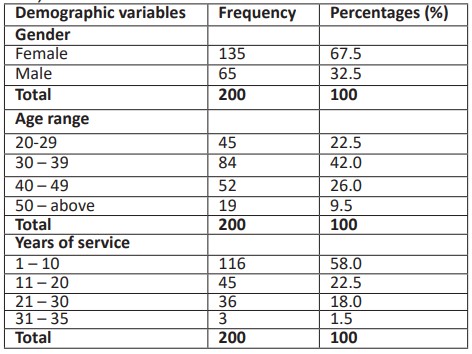
Validity of the Instrument
The characteristics of tests and measurements are what are referred to as validity. Validity is the degree to which a measuring device measures what it is designed to measure. The researcher created the questionnaire as the tool for gathering data, and the project supervisor reviewed it critically before making suggestions. Two experts validated the updated version of the survey for relevance to the objectives, material coverage, and language usage.
Table 1b: Socio-demographic distribution of health workers (n=200).
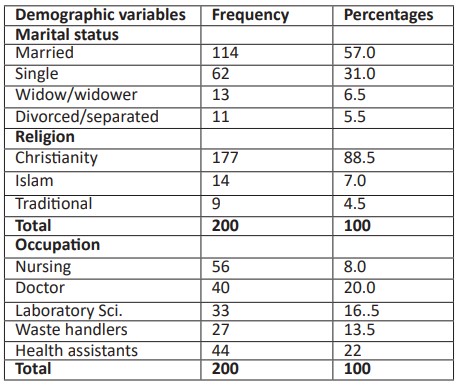
Reliability of the Instrument
Using the test-retest procedure, the instrument's dependability was evaluated. In order to conduct the test, copies of the questionnaire were distributed to twenty (20) respondents who were No table of contents entries found. Representative of the target demographic. The same procedure was repeated a week later in order to evaluate the veracity of the respondents' responses. The Crombach Alpha test was used to determine whether the results were consistent, and a coeffiecient of 0.7 was obtained, indicating that the instrument was deemed to be dependable.
Table 2a: Knowledge and source of information on Standard Precaution.

Mean response > Likert mean (2.5) = significant.
Table 2b: Knowledge and source of information on Standard Precaution.
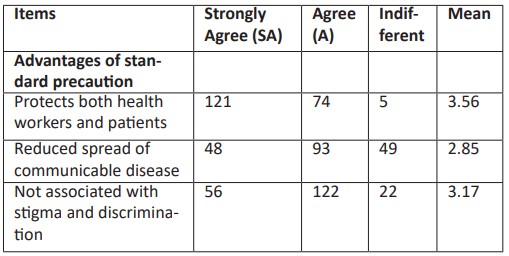
Method of Data Collection
The respondents were given instructions on how to complete the questionnaires as well as the study's goal. Data collection for the project took a few weeks, and during that time I made myself available to respond to questions that were loosely related to it. The questionnaire was used to gather data. After receiving informed consent, the questionnaire was given to the respondents at each department. .copies of the questionnaire that have been completed, collected on the spot.
Method of Data Analysis
Data were collected, entered into the computer and analyzed using SPSS Version 21( Statistical Package for Social Science) In order to analyze the data, descriptive statistics (frequencies, tabular percentages, mean score and standard deviation), as well as the chi-square test, were utilized. Ethical considerations/Informed consent.
The Federal University of Technology, Owerri, School of Health Technology Ethical Review Board granted ethical approval. Before giving out the questionnaires’, informed consent was obtained from the respondents.
Table 3a: Attitude of the respondents towards standard precaution
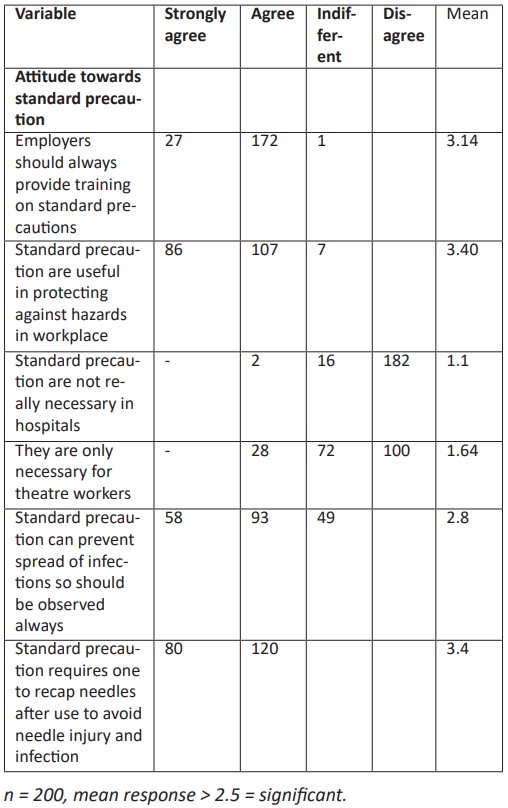
n = 200, mean response > 2.5 = significant.
RESULTS
SOCIO-DEMOGRAPHIC CHARACTERISTICS OF THE RESPONDENTS IN UPTH
The sociodemographic distribution of health workers in UPTH is shown in table 1a above. The findings showed that 67.5% of the participants were female, as opposed to 32.5% of the male peers. The majority (42.0%) of respondents were between the ages of 30 and 39, with 26% of respondents being between the ages of 40 and 49. 9.5% of the population is over 50 and represents a tiny percentage of the older population.
Additionally, the bulk of respondents were still in their first one to ten years of employment, with another 22.5% staying for eleven to twenty years.
Results of analyses on marital status, religion, and occupation are shown in Table 1b above. The majority (57.0%) of the
Table 3b: Attitude of the respondents towards standard pre- caution n (%).

sponding health professionals were married; 31% were single, and the remaining 12% had marital issues ranging from separation to the loss of a spouse. The majority of respondents (85.5%) practiced Christianity, 7% practiced Islam, and only 4.5% stated traditional religion. In this activity, nurses make
Table 4: Practice of standard precaution by the respondents.
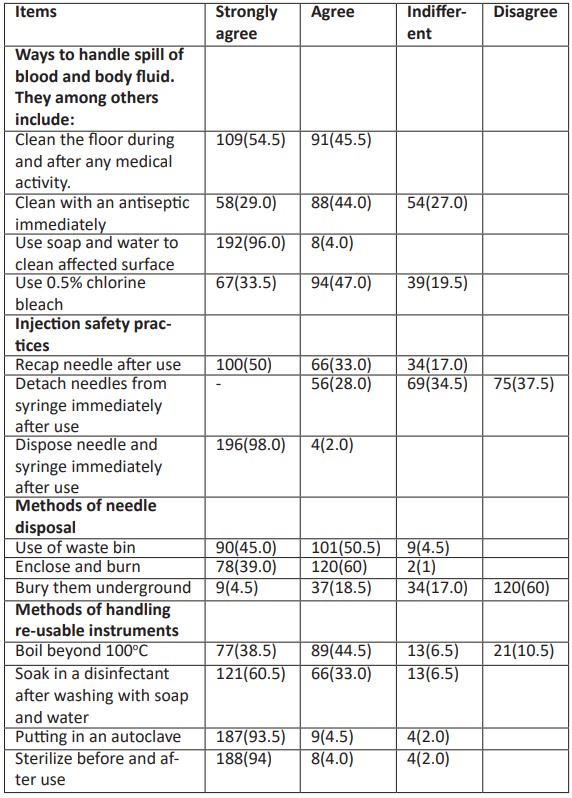
up the majority (28%) of participants, followed by d health assistants (22%) and physicians of medicine (20%).Lab scientists (16.5%) and Waste handlers (13.5%) round out the list.
Level of awareness (knowledge) of the respondents in upth on standard precaution
Results on the respondents' knowledge of standard precaution and the sources from which they learned about it are shown in Tables 2a and 2b. The investigation reveals that everyone (100%) had some prior understanding of conventional precaution as a concept in the healthcare system. Their informational sources, however, ranged from formal education (65%), colleagues/friends (26%) to the media (5.5) and other sources (3.5%). There is strong evidence that standard precaution knowledge and practices are subjected to deliberate training for health professionals.
Table 5: chi-square Hypothesis one.
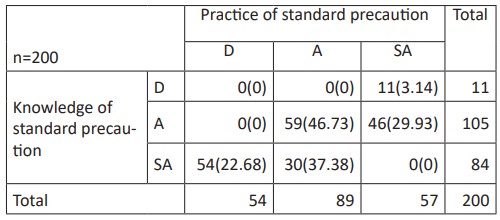
The respondents agreed very well that components of standard precaution include hand hygiene ( x = 3.42), use of personal protective equipment (PPE) ( x = 3.64), safe injection practices ( x = 3.26), safe handling of potentially contaminated equipment surfaces ( x = 3.63), respiratory hygiene etiquette (x= 3.36) and annal/perineal hygiene ( x = 3.14). The response means of items raised under the advantages of standard precaution also revealed that the respondents agreed that practice of standard precaution has immense benefit of which some of it include protection of both health workers and patients ( x = 3.56), reduced spread of communicable disease ( x = 2.85), dealing with the issue of stigmatization and discrimination ( x = 3.17).
Table 6: chi-square Hypothesis two
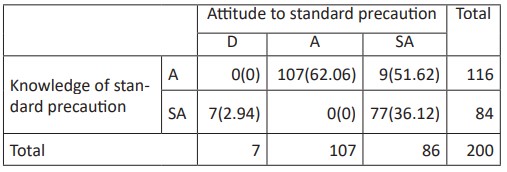
Attitude of medical workers in upth towards standard precaution
The study of the respondents' attitudes about typical precaution techniques was displayed in Table 3a. The respondents believed that it was crucial for every employer in the healthcare system to provide training on common precautions, as evidenced by the mean response of 3.14, which was greater than the likert mean (cut-off).They believed that standard precaution is helpful in the protection against health hazards in
workplace ( x = 3.40). The low response mean of 1.1 and 1.6 is an indication that the health workers in UPTH do not believe standard precaution is not really Table 3b: Attitude of the respondents towards standard precaution n (%) necessary or that it is mainly for those working in the theatre respectively.
On the contrary they believed that standard precaution helps to prevent infections (( x = 2.80) and therefore should always be observed while carrying out any form activity in the hospital. Similar to table 3a, respondents in table 3b responded that it is essential to use double hand gloves (89%), goggles or a
face mask (65%), a gown (90%), and boots (85%) when working with patients who have HIV or HBV. The aforementioned evidence amply demonstrates the positive attitude the UPTH personnel has toward routine precaution.
Practice of Standard Precaution
Results on respondents' use of standard precaution are shown
in Table 4. The outcome showed that the personnel had adopted some procedures for dealing blood and bodily fluid spills. The majority (54.5%) clean their floors before and after medical procedures. 44% of people promptly wipe infected goods with an antiseptic. In order to maintain the hospital rooms free of infections, the medical staff at University of Portharcourt Teaching Hospital also utilizes soap and water to clean infected surfaces (96%) and 0.5% chlorine bleach (94%) were also some ways to disinfect rooms.
Some (50%) thought that recap of needle after use is a safe way to prevent needle injury and transmission of diseases. Safety measures agreed by the respondents include disposal of needles and syringes immediately after use (98%). Method of needle disposal in UPTH include the use of waste bin (50.5%) and enclose and burn (60%).
Test of hypothesis
Statement of hypothesis: knowledge of standard precautions among health care workers do not significantly influence practices in University of Port Harcourt Teaching hospital, Rivers State. chi square is given by:

Chi square = 43.25+3.22+1.46+19.67+8.63 = 76.23
Table value = 9.488
Since the calculated value is higher than the table value, we have sufficient evidence to reject the null hypothesis
chi square is given by:

Chi square (χ2) = 5.66 + 32.54 + 35.18 + 46.42 = 199.80
Table value = 10.597
Since the calculated value is higher than the table value, we have sufficient evidence to reject the null hypothesis
Discussion of Findings
According to the study, more women (67.5%) than men (32.5%) participated in the studies. These women were mostly between the ages of 40 and 49 and had between one and ten years of work experience. Additionally, the analysis revealed that there were more nurses than doctors. This finding is comparable to that of the study (5) conducted, which found that most health workers were nurses working in the wards. This claim is plain to see given the fact that more nurses were employed to help doctors and other healthcare professionals care for the increasing number of people who were admitted in hospitals. This study is comparable to one that was done in France where nurses made up 44% of the group of HCWs analyzed, and another one that was done in Nigeria where nurses made up 50.7% of all the hospital workers studied. This looks to be an indication of the proportion of nurses among HCWs in general (6).
Given how long ago the policy on SP was created, it is not surprising that there was a high level of awareness about Standard Precaution (SP). None of the health care professionals claimed to be unaware that safety measures should be used throughout any type of medical procedure. Everybody (100%) agreed that they had heard of the idea at some point, whether it was through training (school or a workshop), a friend or coworker, the media, or another source. Additionally, it relates to research conducted in the United Arab Emirates, where 97% of respondents were conversant in the idea (7). (8) both claimed to possess a comparable level of knowledge. This demonstrated the level of interest of HCWs in SP, which is most likely related to their belief that Standard precaution is essential for infection control in contexts involving the public health. The majority of the respondents 82.5%) (in the current survey had favorable attitudes toward universal precaution, which is consistent with other findings (9).
Once more, the demonstrated favorable attitude may be the result of their trust in standard precaution (SP), as the SP policy is a solid package intended to stop the spread of nosocomial diseases and guarantee the safety of HCWs while at work. Wearing of PPE was optimally practiced, which is positive because it is essential for infection management in addition to being a key element of SP. This is consistent with a prior study (10). It might be assumed that the respondents' great familiarity with standard precautions prompted them to view them favorably.
In this survey, the respondents (82.5%) have a good attitude toward wearing gloves, a mask, aprons, and boots although in an another study, only 34% of respondents reported wearing gloves and coveralls on a regular basis. The primary explanations for this poor PPE use included sporadic access to PPEs, a lack of time to wear them, and the fact that doing so interferes with clinical duties (11).This demonstrated the need for management and HCWs to work together as closely as possible to implement Standard precaution completely. Secondly, the management should establish an enabling atmosphere by routinely providing PPEs and other necessary resources and supervising their use, while the HCWs should guarantee complete compliance by adhering to established protocols and constantly utilizing resources.
This study shows that standard precaution is highly practiced in UPTH. Over 50% of the respondents asserted that whenever there is spill of blood or body fluid, such is cleaned immediately with either of antiseptic, use of soap and water or 0.5% chlorine bleach.
Majority (60%) do not detach needles from syringe after use. This is a better standard precaution as detaching and capping after use may dispose a health worker to infections. This practice is in line with research conducted by (12) where respondents some of the respondents confirmed that they do not recap needle after use and detach needles from syringe after use. (13) in their work; assessment of knowledge and practice of standard precautions among nurses working at Federal Medical Centre Gombe also opined that trying to detach or recap needles is not a good practice as it is dangerous and may lead to body injury
The hypothesis test in the work showed that the influence of knowledge on practice is not significant enough 9.88, Since the calculated value is higher than the table value, we have sufficient evidence to reject the null hypothesis. . This may imply that there are additional potentially confounding factors of the use of standard precautions in addition to knowledge or training in infection control. Lack of resources and facilities for infection prevention (IPAC) and control has been reported as a major factor influencing poor practice of IPAC in health facilities in Nigeria (14; 2) and other countries of the world (15). It could also be that our respondents practice standard precaution based on availability of resources and not necessarily based on knowledge. Some health workers knowledgeable but may find it inconveniencing using some safety materials. Excess work and time constraints have also been reported by other studies (14; 16).
Conclusion
There has always been a problem with basic precautionary measures, particularly in the Nigerian system. Either there aren't enough safety measures in place, or the medical staff lack the self-control to always use them. This study was carried out to ascertain the level of knowledge, attitude, and standard precaution practice in UPTH. The evidence demonstrated that the medical staff was not at all ignorant of common safety measures. Most of them had formerly taken part in training that taught them the value of following SP standards in order to protect themselves or others. Some people were informed about it through a colleague, media outlet, etc.
While principles of standard precaution should be strictly adhered by surgeons and physicians for their own safety as well as setting leadership roles for their residents, nurses, success in the implementation of SP guidelines depends on so factors such as optimal awareness and a positive attitude in all health care staffs, these goals are not reached without qualified employee receiving continuing education. This study revealed that the health care workers in UPTH has positive attitude towards standard precaution. Bodily fluid or blood spillage were being cleaned immediately they occur with disinfectants to avoid possible infectious contamination. Use of personal protective equipment such as gloves and face masks, and injection safety were some of the safety measures taken by respondents.
Frequent cleaning with antiseptic is been practiced in the hospital. Soap and water were been used for hand hygiene, sometimes chlorine bleach is used to disinfect contaminated surfaces. Even though some healthcare professionals are unawares that recapping needle can be injurious, however needle and syringe were being exposed immediately after use. Method of disposal include use of waste bin, incinerator burning and burying in the ground. In all, all the objective set out for this work were realized.
Recommendations
In order to promote good standard precaution and mitigate the risk of hospital acquired infections, it is necessary for health authorities in Nigeria to institute policies that make it compulsory to establish IPAC (infection control and prevention) committees in all hospitals. Such policies should also outline measures that ensure that IPAC resources are made routinely available and that knowledge and practice of standard precautions are improved through regular IPAC training of hospital staff, with special emphasis on newly qualified health workers such as house officers and staff nurses.
Acknowledgements
The authors wish to thank the study participants for their contribution to the research, as well as current and past investigators and staff.
Financial support and sponsorship: Nil
Conflicts of interest: There is no conflict of interest.
References
- Bennett, G and Mansell, I. (2014). Universal precautions: a survey of community nurses’ experience and practice. International Journal of Clinical Nursing. 1(2): 20 – 27.
- Okechukwu, EF., and Modteshi, C. (2012). Knowledge and practice of standard precautions in public health facilities in Abuja, Nigeria. International Journal of Infection Control 8: 1–7.
- Shuper, PA., Kiene ,SM., Mahlase, G., Macdonald, S., Christie ,S., Cornman, D. H., Fisher, W. A., Greener, R., Lalloo, U. G., Pillay, S., van Loggerenberg, F., and Fisher, JD. (2014). HIV transmission risk behavior among hiv-positive patients receiving antiretroviral therapy in KwaZulu-Natal, South Africa. AIDS Behaviour 18: 1532–1540.
- Ofili ,AN., Asuzu, MC,. and Okojie, OH. (2008). Knowledge and practice of universal precautions among nurses in central hospital, Benin-City, Edo State, Nigeria. Nigerian Postgraduate Medical Journal 10: 26–31.
- Arinze- Onyia SU, Ndu AC, Aguwa EN, Modebe I, Nwamoh UN (2018). Knowledge and Practice of Standard Precautions by Health care workers in a Tertiary Health Institutionin Enugu, Nigeria. Nigerian Journal of clinical practice 21:2 pg149-154.
- Atif, M. L., Brenet ,A., Hageaux ..S., Fave M. H., Cochet. C., Baticle, E. (2013). Awareness of standard precautions for 4439 healthcare professionals in 34 institutions in France. Med Mal Infect;43:10-6 Infectious Diseases 14: e1106–14. International Journal of Infection Control 8: 1–7.
- Sreedharan J., Muttappillymyalil J., Venkatramana M. (2011). Knowledge about standard precautions among university hospital nurses in the United Arab Emirates. East Mediterr Health J 2011;17:331-4.
- Amoran O, Onwube O.(2013). Infection control and practice of standard precautions among healthcare workers in Northern Nigeria. J Glob Infect Dis 2013;5:156-63.
- Parmeggiani C., Abbate R., Marinelli P., Angelillo I. F. (2010). Healthcare workers and health care-associated infections: Knowledge, attitudes, and behavior in emergency departments in Italy. BMC Infect Dis; 10:35.
- Punia ,S., Nair S., Shetty, R. S. (2014). Healthcare workers and standard precautions perceptions and determinants of compliance in the emergency and trauma triage of a tertiary care hospital in South India. International School of Research Notices 2014:5. [Doi: 10.1155/2014/685072].
- Mukherjee, S, Bhattacharyya, A, SharmaSarkar, B, Goswami, DN, Ghosh,S, Samanta A,( 2012). Knowledge and practice of standard precautions and awareness regarding post-exposure prophylaxis for HIV among interns of a medical college in West Bengal, India. International Journal of Infection Control 15: 1–7.
- Tobin E. A. Asogun D. A., Odia I., Ehidiamhen G. (2013) Knowledge and practice of infection control among health workers in a tertiary hospital in Edo State, Nigeria. Direct Research Journal of Health Pharmacy. 1(2): 20 – 27.
- Abubakar, S. M. Haruna, H., Teryila, K. R., Hamina, D., Ahmadu, I, Babaji, M., (2015). Assessment of knowledge and practice of standard precautions among nurses working at Federal Medical Centre Gombe, Nigeria. Direct Research Journal of Health Pharmacy. 3(1): 1-11.
- Adinma, .ED., Ezeama, C., and Asuzu , M,C. (2009). Knowledge and practice of universal precautions against blood borne pathogens amongst house officers and nurses in tertiary health institutions in Southeast Nigeria. Nigerian Journal of Clinical Practice 77: 1079–1082..
- Reda ,A,A., Fisseha, S., Mengistie, B, and Vandeweerd, J-M. (2010). Standard precautions: occupational exposure and behavior of health care work-ers in Ethiopia. PLoS One 5: e14420.
- Luo ,Y, He, G., Zhou, J,. and Luo, Y. (2010). Factors impacting compliance with standard precautions in nursing, China. International Journal of Infectious Diseases 14: e1106–14.

